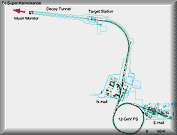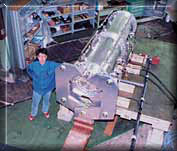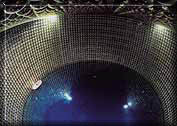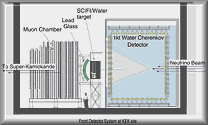Long-Baseline Neutrino Oscillation Experiment
KEK is presently preparing for a long-baseline neutrino oscillation experiment linking KEK to Kamioka.
In this plan, a high-intensity muon neutrino beam (average energy of 1.5GeV) produced at the KEK-PS will be injected to the Super-Kamiokande located 250km west of KEK
 The distance and neutrino energy are quite suitable to explore Dm2 >a few x 10-3 eV2 region. The commissioning of the neutrino beam is scheduled in January, 1999. The primary proton beam will be bent from the North Hall to a target station, passing through a newly-made beam line. Construction will be finished in March, 1998. The distance and neutrino energy are quite suitable to explore Dm2 >a few x 10-3 eV2 region. The commissioning of the neutrino beam is scheduled in January, 1999. The primary proton beam will be bent from the North Hall to a target station, passing through a newly-made beam line. Construction will be finished in March, 1998.
To verify the existence of neutrino oscillations, we will compare the neutrino energy spectra measured with the far-detector at Kamioka and with the near-detector at KEK. For this purpose, the near detector system is under construction at 300 m downstream of the target. It consists of a one kilo-ton water Cherenkov detector and a Fine-Grained Detector (FGD) system. FGD is composed of (i) water target with 4-ton fiducial volume interleaved every 6 cm by scintillating fiber sheets, (ii) EM shower calorimeter of 600 lead-glass blocks, and (iii) muon range detector with 12 pairs of iron plates and chamber layers. The muon neutrino energy spectrum is reconstructed by detecting each charged current quasi-elastic interaction (CCQE). Electron neutrino contamination rate in the original beam, estimated to be about 1%, is obtained from (i) and (ii). The expected event rate is 4 x 104 CCQE interactions for the 4-ton fiducial volume of FGD in 3 years of running, which should be compared to what we will obtain in the Super-Kamiokande ( 200 CCQE and 400 total charged current events without oscillation ). Any overall deficit in the number of muon neutrino, distortion of their spectra, and/or appearance of electron neutrino events is the signature for the neutrino oscillation.
The HORN magnet system consists of a target and the surrounding cylindrical conductors both made of aluminum. A large pulsed current is applied to generate a strong magnetic field, focusing secondary pions to the detector direction. A series of tests were performed. A long-term operation test with the nominal current have been taking place since July, 1997.
 |
 |
 |
|
HORN magnet system |
Super Kamiokande(ICRR, University of Tokyo) |
Front Detector System at KEK site |
|

